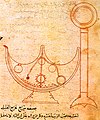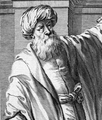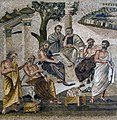Portal:History of science
The History of Science Portal
The history of science covers the development of science from ancient times to the present. It encompasses all three major branches of science: natural, social, and formal. Protoscience, early sciences, and natural philosophies such as alchemy and astrology during the Bronze Age, Iron Age, classical antiquity, and the Middle Ages declined during the early modern period after the establishment of formal disciplines of science in the Age of Enlightenment.
Science's earliest roots can be traced to Ancient Egypt and Mesopotamia around 3000 to 1200 BCE. These civilizations' contributions to mathematics, astronomy, and medicine influenced later Greek natural philosophy of classical antiquity, wherein formal attempts were made to provide explanations of events in the physical world based on natural causes. After the fall of the Western Roman Empire, knowledge of Greek conceptions of the world deteriorated in Latin-speaking Western Europe during the early centuries (400 to 1000 CE) of the Middle Ages, but continued to thrive in the Greek-speaking Byzantine Empire. Aided by translations of Greek texts, the Hellenistic worldview was preserved and absorbed into the Arabic-speaking Muslim world during the Islamic Golden Age. The recovery and assimilation of Greek works and Islamic inquiries into Western Europe from the 10th to 13th century revived the learning of natural philosophy in the West. Traditions of early science were also developed in ancient India and separately in ancient China, the Chinese model having influenced Vietnam, Korea and Japan before Western exploration. Among the Pre-Columbian peoples of Mesoamerica, the Zapotec civilization established their first known traditions of astronomy and mathematics for producing calendars, followed by other civilizations such as the Maya.
Natural philosophy was transformed during the Scientific Revolution in 16th- to 17th-century Europe, as new ideas and discoveries departed from previous Greek conceptions and traditions. The New Science that emerged was more mechanistic in its worldview, more integrated with mathematics, and more reliable and open as its knowledge was based on a newly defined scientific method. More "revolutions" in subsequent centuries soon followed. The chemical revolution of the 18th century, for instance, introduced new quantitative methods and measurements for chemistry. In the 19th century, new perspectives regarding the conservation of energy, age of Earth, and evolution came into focus. And in the 20th century, new discoveries in genetics and physics laid the foundations for new sub disciplines such as molecular biology and particle physics. Moreover, industrial and military concerns as well as the increasing complexity of new research endeavors ushered in the era of "big science," particularly after World War II. (Full article...)
Selected article -

Astronomical symbols are abstract pictorial symbols used to represent astronomical objects, theoretical constructs and observational events in European astronomy. The earliest forms of these symbols appear in Greek papyrus texts of late antiquity. The Byzantine codices in which many Greek papyrus texts were preserved continued and extended the inventory of astronomical symbols. New symbols have been invented to represent many planets and minor planets discovered in the 18th to the 21st centuries.
These symbols were once commonly used by professional astronomers, amateur astronomers, alchemists, and astrologers. While they are still commonly used in almanacs and astrological publications, their occurrence in published research and texts on astronomy is relatively infrequent, with some exceptions such as the Sun and Earth symbols appearing in astronomical constants, and certain zodiacal signs used to represent the solstices and equinoxes. (Full article...)
Selected image

In this set of drawings from 1616, Galileo Galilei recorded the uneven curve of the Sun's light along the lunar surface, indicating variations in elevation. Galileo's telescope observations of the Moon and other heavenly bodies helped to convince 17th century scholars to abandon the notion of the heavens as perfect and unchanging. Before the rise of telescopic observations, the Moon was still considered by some Jesuit astronomers to be flat, with the visible spots caused by variations in density or optical phenomena. Galileo had planned a more extensive program of observations and illustrations, finding little resistance to a rough Moon, made no further lunar drawings after these.
Did you know
...that in the history of paleontology, very few naturalists before the 17th century recognized fossils as the remains of living organisms?
...that on January 17, 2007, the Doomsday Clock of the Bulletin of the Atomic Scientists moved to "5 minutes from midnight" in part because of global climate change?
...that in 1835, Caroline Herschel and Mary Fairfax Somerville became the first women scientists to be elected to the Royal Astronomical Society?
Selected Biography -

Su Song (Chinese: 蘇頌; Pe̍h-ōe-jī: So͘ Siōng, 1020–1101), courtesy name Zirong (Chinese: 子容; Pe̍h-ōe-jī: Chú-iông), was a Chinese polymathic scientist and statesman. Excelling in a variety of fields, he was accomplished in mathematics, astronomy, cartography, geography, horology, pharmacology, mineralogy, metallurgy, zoology, botany, mechanical engineering, hydraulic engineering, civil engineering, invention, art, poetry, philosophy, antiquities, and statesmanship during the Song dynasty (960–1279).
Su Song was the engineer for a hydro-mechanical astronomical clock tower in medieval Kaifeng, which employed an early escapement mechanism. The escapement mechanism of Su's clock tower had been invented by Tang dynasty Buddhist monk Yi Xing and government official Liang Lingzan in 725 AD to operate a water-powered armillary sphere, although Su's armillary sphere was the first to be provided with a mechanical clock drive. Su's clock tower also featured the oldest known endless power-transmitting chain drive, called the tian ti (天梯), or "celestial ladder", as depicted in his horological treatise. The clock tower had 133 different clock jacks to indicate and sound the hours. Su Song's treatise about the clock tower, Xinyi Xiangfayao (新儀象法要), has survived since its written form in 1092 and official printed publication in 1094. The book has been analyzed by many historians, such as the British biochemist, historian, and sinologist Joseph Needham. The clock itself, however, was dismantled by the invading Jurchen army in 1127 AD, and although attempts were made to reassemble it, the tower was never successfully reinstated. (Full article...)
Selected anniversaries
- 1561 - Birth of Sir Francis Bacon, English philosopher (d. 1626)
- 1592 - Birth of Pierre Gassendi, French philosopher, mathematician, and scientist (d. 1655)
- 1767 - Death of Johann Gottlob Lehmann, German minterologist and geologist (b. 1719)
- 1796 - Birth of Karl Claus, Russian chemist (d. 1864)
- 1903 - Birth of Fritz Houtermans, Polish physicist (d. 1966)
- 1908 - Birth of Lev Landau, Soviet physicist, Nobel laureate (d. 1968)
- 1922 - Death of Camille Jordan, French mathematician (b. 1838)
- 1936 - Birth of Alan J. Heeger, American chemist, Nobel laureate
Related portals
Topics
General images
Subcategories
Things you can do
Help out by participating in the History of Science Wikiproject (which also coordinates the histories of medicine, technology and philosophy of science) or join the discussion.
Associated Wikimedia
The following Wikimedia Foundation sister projects provide more on this subject:
-
Commons
Free media repository -
Wikibooks
Free textbooks and manuals -
Wikidata
Free knowledge base -
Wikinews
Free-content news -
Wikiquote
Collection of quotations -
Wikisource
Free-content library -
Wikiversity
Free learning tools -
Wiktionary
Dictionary and thesaurus








































































